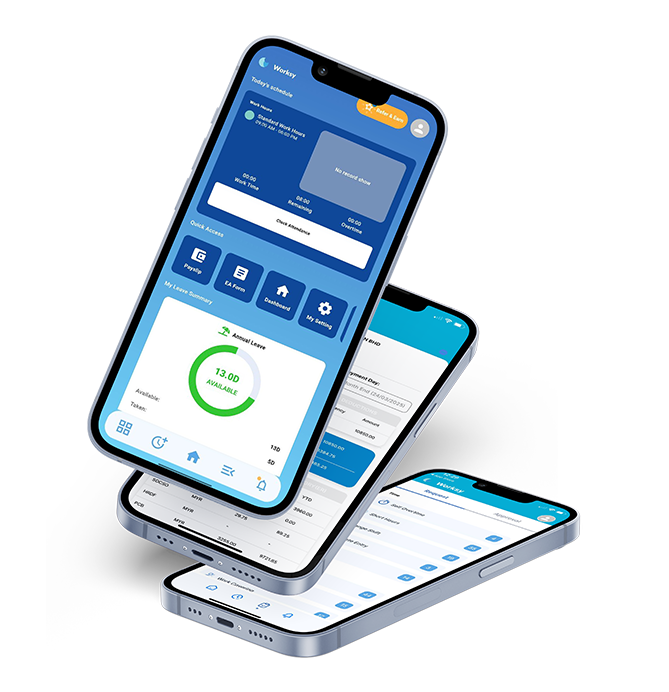scheduled free Worksy HRMS demo.

When to Start Maternity Leave Malaysia: Early Leave Guide
June 12, 2025Paternity Leave in Malaysia: Guide to Rights and Application
The arrival of a new child is a momentous occasion, and in Malaysia, fathers now have legally recognized paid time off to support their partners and bond with their newborns. Understanding your paternity leave rights and the application process is essential for expectant fathers and crucial for HR professionals managing these entitlements. This guide provides a comprehensive overview of paternity leave in Malaysia, including its duration, eligibility, application procedures, and how HR solutions like Worksy HRMS can streamline its management.
Understanding Paternity Leave in Malaysia: A Significant Entitlement
Paternity leave signifies a growing recognition of the father’s role in early childcare and family well-being. Recent changes to Malaysian law have formalized this important benefit for many working fathers.
What is Paternity Leave?
Paternity leave is a short period of paid leave granted to a male employee upon the birth of his child. This allows him to care for his wife post-childbirth and to bond with his newborn child. It acknowledges the shared responsibilities of parenthood from the very beginning. For a broader view of family-related leave, you might also be interested in parental leave in Malaysia.

Automate HR with Worksy - trusted by 3,000+ companies.
Request free demo now*Terms and conditions apply.
The Importance of Paternity Leave for Fathers and Families
Paternity leave offers numerous benefits:
- Supports Maternal Health: It allows fathers to provide crucial support to mothers recovering from childbirth.
- Strengthens Father-Child Bonding: Early interaction is vital for developing a strong bond between father and child.
- Promotes Gender Equality: It encourages shared parenting responsibilities and challenges traditional gender roles.
- Boosts Employee Morale and Loyalty: Companies that support paternity leave often see increased employee loyalty and satisfaction. This ties into broader strategies for employee benefits in Malaysia.
Recent Legal Developments: Paternity Leave Under the Employment Act 1955
A significant milestone for working fathers in Malaysia was the amendment to the Employment Act 1955, which came into effect on January 1, 2023. This amendment mandated paid paternity leave for eligible employees in the private sector, aligning Malaysia with growing global standards. Staying updated with latest labour laws in Malaysia is crucial for both employers and employees.
Key Paternity Leave Entitlements in Malaysia
Fathers in Malaysia are entitled to specific provisions regarding their leave. Understanding these details is key to utilizing the benefit correctly.
How Many Days of Paternity Leave Can Fathers Take?
Eligible male employees in Malaysia are entitled to seven (7) consecutive days of paid paternity leave for each confinement.
Is Paternity Leave in Malaysia Paid?
Yes, the 7 days of paternity leave are paid leave. This means the employee will receive his usual wages during this period, provided he meets all eligibility criteria. The introduction of paid leave is a major step forward.
Eligibility Criteria for Paternity Leave
To be eligible for paid paternity leave under the Employment Act 1955, a male employee must meet the following conditions:
- Employment Period: He must have been employed by the same employer for at least twelve (12) months immediately before the commencement of such leave.
- Marital Status: He must be married to the mother of the child. This is a critical legal requirement.
- Notification: He must have notified his employer of his wife’s pregnancy at least thirty (30) days from the expected confinement or as early as possible after the birth.
- Limitation on the Number of Births: The entitlement to paid paternity leave is restricted to a maximum of five (5) confinements, irrespective of the number of spouses.
Conditions and Restrictions for Taking Paternity Leave
There are specific conditions attached to taking paternity leave:
- Timing of Leave: The leave must be taken starting from the day of his wife’s confinement (childbirth).
- Consecutive Days Requirement: The 7 days of leave must be taken in a single, continuous block. It cannot be split or staggered.
Applying for Paternity Leave: A Step-by-Step Guide for Employees
Properly applying for paternity leave ensures a smooth process and avoids any misunderstandings with your employer.
Notifying Your Employer: When and How?
Timely notification is a legal requirement and good practice.
- Recommended Notice Period: An employee must notify his employer of his spouse’s pregnancy and the expected due date at least thirty (30) days before the expected confinement, or as soon as practicable after the birth if earlier notification was not possible (e.g., premature birth).
- Written Notification vs. Verbal: While the law emphasizes notification, it is always best practice to provide this notification in writing (e.g., email or official company form) for record-keeping purposes.
Required Documentation for Paternity Leave Application
Employers may require certain documents to process the paternity leave application and verify eligibility:
- Birth certificate of the child: This is typically required after the birth to confirm the confinement.
- Marriage certificate: To verify the marital status with the child’s mother.
- Company-specific application forms: Many companies have their own leave application forms or procedures through an eLeave management system.
What to Expect After Submitting Your Application
Once you have submitted your notification and any required forms, your employer should acknowledge your request. Ensure you understand when the leave will commence (i.e., on the day of birth) and confirm any handover plans for your work responsibilities.
Employer Responsibilities and HR Management of Paternity Leave
Employers and HR departments play a vital role in implementing paternity leave policies effectively and legally.
Understanding and Complying with Legal Obligations
Employers must adhere to the Employment Act 1955 provisions regarding paternity leave. This includes granting the 7 paid days to eligible employees and not penalizing them for taking this leave. Ensuring compliance is a core HR function, and how HR systems keep Malaysian businesses at the forefront of compliance is a relevant consideration.
Developing and Communicating Clear Paternity Leave Policies
Companies should have a clear, written policy on paternity leave that outlines:
- Eligibility criteria
- Duration of leave
- Notification requirements
- Application process
- Required documentation
This policy should be easily accessible to all employees, perhaps as part of an employee handbook or an internal HR portal.
Can an Employer Deny a Valid Paternity Leave Request?
An employer cannot deny a paternity leave request if the employee meets all the eligibility criteria stipulated under the Employment Act 1955 and has followed the proper notification procedures. Denying legally mandated leave can lead to industrial relations disputes.
Managing Paternity Leave with Worksy HRMS
A modern Human Resource Management System (HRMS) like Worksy can significantly simplify the administration of paternity leave for both employees and HR.
- Simplifying leave requests and approvals for fathers: Employees can easily submit paternity leave notifications and applications through the system.
- Automated tracking of paternity leave entitlements: Worksy HRMS can automatically track eligibility (e.g., 12 months service, limit of 5 confinements) and the 7-day leave balance.
- Ensuring compliance and accurate record-keeping: The system maintains digital records of applications, approvals, and leave taken, which is crucial for compliance and audits. HR analytics can also provide insights into leave trends.
- Facilitating smooth workforce planning during absences: Managers can have better visibility of planned absences, aiding in resource allocation.
For companies looking to modernize, cloud HRMS offers a streamlined solution for HR processes.
Paternity Leave in the Public vs. Private Sector in Malaysia
While the Employment Act 1955 primarily covers private-sector employees, public sector employees also have provisions for paternity leave.
Are There Differences in Entitlements?
Yes, there can be differences. Public sector employees (government servants) in Malaysia are typically governed by specific government circulars. For example, circulars like MyPPSM Ceraian SR.5.4.2 provide for 7 days of paid paternity leave (cuti isteri bersalin) under conditions that may differ slightly from the Employment Act, such as the notice period or specific application forms.
Specific Circulars or Guidelines for Government Employees (Brief Overview)
Government employees should refer to the latest Treasury Circulars or Public Service Department (JPA) guidelines for the most accurate information regarding their paternity leave entitlements. These circulars detail the conditions, application process, and any specific forms required.
What if Your Paternity Leave Rights are Violated?
Employees who believe their paternity leave rights have been unfairly denied or violated have avenues for recourse.
Understanding Your Recourse
If an eligible employee is denied paid paternity leave or faces adverse action for taking it, this could be considered a breach of the Employment Act 1955.
Channels for Complaint or Dispute Resolution
An employee can lodge a complaint with the Department of Labour Peninsular Malaysia (JTKSM) or the relevant labour office in Sabah or Sarawak. JTKSM can investigate the matter and help mediate or make an order.
Frequently Asked Questions (FAQ) about Paternity Leave in Malaysia
Here are some common questions regarding paternity leave in Malaysia:
When did paid paternity leave become mandatory for private sector employees in Malaysia?
Paid paternity leave of 7 consecutive days for eligible private sector employees became mandatory with the enforcement of the Employment (Amendment) Act 2022 on January 1, 2023.
Can I take paternity leave if my child is adopted?
The current provisions under the Employment Act 1955 for the 7 days paid paternity leave are specifically tied to “confinement” (childbirth) and require the employee to be married to the mother. Therefore, it generally does not cover adoption. Employees should check if their company has a separate policy for adoption leave.
What happens if my wife gives birth prematurely before I’ve officially given the 30-day notice?
The law states that notification should be given 30 days prior or as early as possible after the birth. In cases of premature birth, you should notify your employer immediately. Your entitlement to leave should still be valid provided you meet other criteria.
Does paternity leave affect my annual leave or other leave entitlements?
No, paternity leave is a separate entitlement. It should not be deducted from your annual leave, sick leave, or any other leave entitlement in Malaysia.
Can my employer ask me to work during my paternity leave?
Paternity leave is intended for you to be away from work to care for your wife and newborn. While urgent, brief communication might occasionally be necessary in some roles, you are generally not required to perform regular work duties during your approved paternity leave.
Conclusion: Embracing Fatherhood with Supported Paternity Leave
The introduction of mandatory paid paternity leave in Malaysia is a progressive step that acknowledges the vital role fathers play in the early stages of a child’s life and in supporting their partners. For expectant fathers, understanding your rights and the application process is key to utilizing this benefit. For employers and HR professionals, ensuring compliance and fostering a supportive environment is paramount.
Tools like Worksy HRMS can significantly aid in managing paternity leave requests efficiently, ensuring legal compliance, and supporting employees during this important family milestone. By embracing and properly administering paternity leave, companies contribute to a more equitable and family-friendly work culture in Malaysia.

Tired of HR chaos? Let Worksy simplify your workflow.
Request free demo now*Terms and conditions apply.




